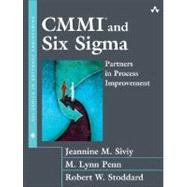
What is included with this book?
Jeannine M. Siviy is the Deputy Director for the Dynamic Systems Program of the Software Engineering Institute (SEI), a Kodak-certified Six Sigma Black Belt, and a leading researcher in the application of Six Sigma to software process improvement. M. Lynn Penn is Director of Program Process Management at Lockheed Martin Information Systems and Global Services (IS&GS), where she oversees policies and process command media, process compliance via audits, and process improvement activities. She is a Lockheed-certified Lean Six Sigma Black Belt. Robert W. Stoddard is a Senior Member of the Technical Staff at the SEI, a Motorola-certified Six Sigma Master Black Belt, and President and CEO of Six Sigma IDS, LLC.
| List of Figures | p. xiii |
| List of Tables | p. xvii |
| Foreword | p. xix |
| Foreword | p. xxi |
| Preface | p. xxiii |
| Introduction | p. 1 |
| CMMI Overview | p. 5 |
| CMMI at a Glance | p. 6 |
| Adoption and Deployment | p. 15 |
| Benefits | p. 16 |
| CMMI Adoption Myths | p. 17 |
| Summary | p. 18 |
| Six Sigma Overview | p. 19 |
| Six Sigma at a Glance | p. 21 |
| Deployment | p. 35 |
| Applying Six Sigma to Software | p. 37 |
| Six Sigma Myths | p. 39 |
| Example Benefits | p. 43 |
| Summary | p. 44 |
| Multimodel Process Improvement: The Value Proposition | p. 45 |
| Six Sigma as a Strategic Enabler: An Investigation | p. 47 |
| Summary | p. 52 |
| Two Case Studies | p. 55 |
| Case Study: Lockheed Martin Integrated Systems & Solutions | p. 55 |
| Case Study: Motorola | p. 75 |
| Summary | p. 88 |
| Integrating the CMMI and Six Sigma: Strategies | p. 91 |
| Sequencing Scenarios | p. 91 |
| Joint Implementation Strategies | p. 93 |
| Considerations for Staged and Continuous CMMI Representations | p. 97 |
| Considerations for Joint Deployment | p. 100 |
| Summary | p. 105 |
| Integrating the CMMI and Six Sigma: Design Connections | p. 107 |
| CMMI Process Areas and Six Sigma Frameworks | p. 107 |
| CMMI Process Areas and the Six Sigma Toolkit of Analytical Methods | p. 112 |
| CMMI Project Management Process Areas and Six Sigma Project Management | p. 112 |
| CMMI Process Outputs as Inputs to Six Sigma and Vice Versa | p. 113 |
| Summary | p. 114 |
| Multimodel Process Improvement: The General Case | p. 115 |
| Depiction of the Process of Process Improvement | p. 116 |
| Mission Translation and Project Portfolio Management | p. 123 |
| Model Selection and Strategy | p. 134 |
| Solution Implementation: Process Architecture and Design | p. 139 |
| Summary | p. 146 |
| Sustainment: Your Improvement Project Portfolio | p. 147 |
| Product Quality Improvement | p. 149 |
| Cost and Schedule Performance Improvement | p. 158 |
| Definition and Design of the Decision Analysis Process | p. 172 |
| IT Operations: Value Stream Mapping with IT Tools | p. 176 |
| Performance Modeling and Simulation | p. 181 |
| Summary | p. 188 |
| Summary and Final Remarks | p. 189 |
| DMAIC Roadmap Guidance Questions | p. 193 |
| DMAIC and CMMI Specific Goals and Generic Practices | p. 197 |
| CMMI Process Areas and the Six Sigma Toolkit | p. 199 |
| "Six Sigma as an Enabler" Research Project: Full Report | p. 203 |
| "Six Sigma as an Enabler" Research Project: Findings, Inferences, Hypotheses | p. 215 |
| Overview of Frequently Used Six Sigma Analytical Methods | p. 227 |
| Measurement Practices | p. 251 |
| Transition Practices | p. 261 |
| Organizational Change Management | p. 267 |
| References | p. 271 |
| Additional Resources | p. 283 |
| Acronyms | p. 299 |
| About the Authors | p. 309 |
| Index | p. 315 |
| Table of Contents provided by Publisher. All Rights Reserved. |
The New copy of this book will include any supplemental materials advertised. Please check the title of the book to determine if it should include any access cards, study guides, lab manuals, CDs, etc.
The Used, Rental and eBook copies of this book are not guaranteed to include any supplemental materials. Typically, only the book itself is included. This is true even if the title states it includes any access cards, study guides, lab manuals, CDs, etc.